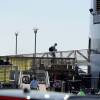It had been some time since NASA had a project that captured the public's imagination like the launch of the Hubble Space Telescope in April 1990.
"You didn’t have to be at NASA to be excited about Hubble," said former NASA astronaut Jeff Hoffman, who now teaches at MIT. "People were really looking forward to this great new telescope that was going to be able to see farther away than any other telescopes and reveal the secrets of the universe," he said.
Once in space, the shuttle Discovery opened it’s hatch and lifted Hubble into position. Once the systems were carefully switched on, all that was left to do was cut the cord. And just like that, the strongest space telescope in human history was released into orbit.
But, Houston, they had a problem. The optics were off — by less than 1/50 of the width of a human hair — but it was enough. Every image the telescope returned was blurry. It was an unmitigated disaster.
"Jokes from late night comedians, a movie where they had a picture of Hubble next to the Tacoma Narrows bridge and the Hindenburg as history’s great disasters, Barbara Mikulski denouncing Hubble as a techno turkey in the halls of the U.S. Congress, I mean, it was terrible," Hoffman said.
Hubble had presciently been designed from the start to be serviceable by astronauts, though no one expected it to need such a critical fix so fast. Hoffman was one of seven astronauts tapped for the job. It was a big deal. The failing multibillion-dollar telescope was under the microscope.
"We got called down to NASA headquarters to meet with Dan Goldin, who was the NASA administrator at the time," Hoffman said. "And I’ll always remember sitting across from his desk and he looked at us and he said, ‘I hope you realize that the future of NASA's human space flight program depends on the success of your mission.'"
'The thrill of putting my hands on the Hubble telescope up in space — I mean, it doesn't get any better than that.'
That December 1993 mission was the most complex flight in the history of the shuttle program: 10 days in space, a record five spacewalks, three of them competed by Hoffman. The mission went spectacularly, but it would be weeks before they knew whether the repairs actually worked.
Hoffman got a call from a friend at the Science Institute at 1 a.m. on New Years Day, as he was cleaning up from a party at his home.
"I’ll always remember, they said, ‘Do you have any champagne in the refrigerator?’ And yeah, we had a half bottle left over, and he said, ‘Go pour yourself a glass and we’re going to drink a toast because, I’m not really supposed to tell anybody, but we got the first pictures back from Hubble and it worked. It’s perfect.’"
In the years since, Hubble has produced some of the most iconic and breathtaking images of our universe ever seen, fundamentally changed our understanding of the universe and completely rewritten astronomy books.
And it’s still going strong. Upgraded most recently in 2009, it continues to peer into the deepest recesses of space, and back into time.
As for Hoffman, he sometimes finds himself in his office at MIT, reflecting back on those moments all those years ago, suspended between heaven and earth, with the hopes of countless scientists and the future of NASA in his hands.
"It’s another world up there," he said. "It’s a completely different plane of human existence to be weightless, in a space suit, in a vacuum. That’s the most intimate experience of what being in space is like. As an astronomer and an astronaut, I mean, the thrill of putting my hands on the Hubble telescope up in space — I mean, it doesn’t get any better than that."
Jeff Hoffman, the man who fixed the Hubble telescope, which was launched into space and released into orbit, 24 years ago this week.
An earlier version of this story erroneously stated the last Hubble service mission was in 1998.




